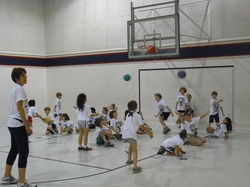Eagles In Motion

Every new academic year, when the tennis shoes are still squeaky clean and students are eager to please, I have to remind them that Health & Fitness class is not about sports. Yes, we spend some time on certain skills (dribbling, batting, tagging, jumping, etc.) in respect to lead-up games, but Health & Fitness class is about movement and healthy life choices. With a greater amount of our population becoming obese, especially children, it is more important than ever that students find some kind of movement and aerobic activity they enjoy and will continue doing in later years.
I meet twice weekly with Grade K-4 and once a week with Grade 5-8. Each session lasts 40 minutes and begins with a quick prayer on the “prayer circle.” Students then respond to two whistle blows by hustling to their stretching and exercise spots where we usually spend 4-6 minutes warming up. At this point, some fitness activity is in order---jogging, sprinting, dancing, etc. Students are more than ready to move around after a morning or afternoon of classes! The remaining time is dedicated to instruction and a game activity. And do we cover the gamut---relay races, parachute activities, soccer skills, whistle drills, kicking, dribbling, dodging, shooting, basketball, flag football, balancing activities, cooperative games with partners, floor hockey, kickball, batting, strength exercises, and bean bag activities to name a few. Of course there’s tennis, jax, tumbling, noodle fun, bucket stilts, rhythm activities, jump rope, hula hoops, croquet, and volleyball. We can’t forget badminton, Billy Ball, Threeball, four square challenges, hurdles, and balloon play. Did I mention water aerobics (7th/8th Girls), bowling (7th/8th Grade Boys), scooters, Alaskan football, Gertie ball, Skip It, and wiffle ball? Whew! We do like to keep moving, learn new skills, and fine-tune old ones.
We talk about healthy eating choices, the food pyramid, serving sizes, and calories. Other health issues are covered like tobacco and alcohol use, sleep requirements, and hygiene issues. Personal safety precautions like wearing helmets for biking and other mobile activities are topics for discussion during class. My belief is the more children hear and, better yet, see a role model being health conscious, the more likely they will incorporate these behaviors into their daily lives. It begins at home, of course, but it is certainly reinforced at St. Ann.
There are four areas in which students are graded: Readiness (25%), Participation (25%), Effort (25%), and Conduct (25%). Readiness simply entails wearing tennis shoes to class and being ready for the prayer circle, warm up, and instruction; Participation required students to be actively involved throughout the period; Effort is trying---even if you can’t always master a skill or activity; and Conduct, of course, involves listening and cooperation (with the teacher and with teammates). A student’s Health & Fitness grade will be averaged with other grades when determining overall average for the quarter or semester.
I meet twice weekly with Grade K-4 and once a week with Grade 5-8. Each session lasts 40 minutes and begins with a quick prayer on the “prayer circle.” Students then respond to two whistle blows by hustling to their stretching and exercise spots where we usually spend 4-6 minutes warming up. At this point, some fitness activity is in order---jogging, sprinting, dancing, etc. Students are more than ready to move around after a morning or afternoon of classes! The remaining time is dedicated to instruction and a game activity. And do we cover the gamut---relay races, parachute activities, soccer skills, whistle drills, kicking, dribbling, dodging, shooting, basketball, flag football, balancing activities, cooperative games with partners, floor hockey, kickball, batting, strength exercises, and bean bag activities to name a few. Of course there’s tennis, jax, tumbling, noodle fun, bucket stilts, rhythm activities, jump rope, hula hoops, croquet, and volleyball. We can’t forget badminton, Billy Ball, Threeball, four square challenges, hurdles, and balloon play. Did I mention water aerobics (7th/8th Girls), bowling (7th/8th Grade Boys), scooters, Alaskan football, Gertie ball, Skip It, and wiffle ball? Whew! We do like to keep moving, learn new skills, and fine-tune old ones.
We talk about healthy eating choices, the food pyramid, serving sizes, and calories. Other health issues are covered like tobacco and alcohol use, sleep requirements, and hygiene issues. Personal safety precautions like wearing helmets for biking and other mobile activities are topics for discussion during class. My belief is the more children hear and, better yet, see a role model being health conscious, the more likely they will incorporate these behaviors into their daily lives. It begins at home, of course, but it is certainly reinforced at St. Ann.
There are four areas in which students are graded: Readiness (25%), Participation (25%), Effort (25%), and Conduct (25%). Readiness simply entails wearing tennis shoes to class and being ready for the prayer circle, warm up, and instruction; Participation required students to be actively involved throughout the period; Effort is trying---even if you can’t always master a skill or activity; and Conduct, of course, involves listening and cooperation (with the teacher and with teammates). A student’s Health & Fitness grade will be averaged with other grades when determining overall average for the quarter or semester.
